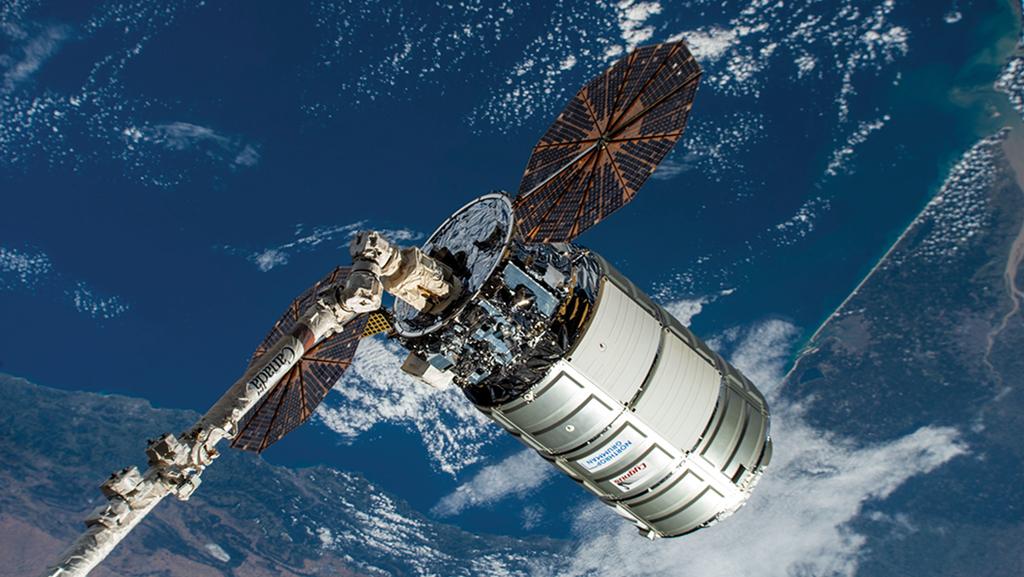Northrop Expands Business Ventures Around Cygnus Cargo Spacecraft

Northrop Grumman plans to increase the cargo capacity of its Cygnus cargo spacecraft from 3,750 kg to 5,000 kg (8,270-11,000 lb.).
Northrop Grumman is developing several future business lines around its decade-old Cygnus space freighter.
The uncrewed cargo spacecraft, originally developed by Orbital Sciences Corp. and first launched in 2013, forms the backbone of Northrop’s efforts to build a commercial space station, to resupply future third-party commercial space stations and to develop a NASA outpost orbiting the Moon—missions that would take the vehicle well into the 2030s.
In the near term, Northrop Grumman plans to increase the cargo capacity of the spacecraft from 3,750 kg to 5,000 kg (8,270-11,000 lb.) The Cygnus Mission B version is planned to be lengthened about 1.5 m (5 ft.) as it is expanded from a three- to four-barrel configuration.
The legacy version of the Cygnus is scheduled to fly three more times, launching aboard SpaceX Falcon 9 rockets while Northrop’s Antares undergoes a modification. The Mission B version would become the company’s standard space freighter when it launches as part of the NG-23 mission, Lucas Migliorini, Northrop Grumman cargo logistics development engineering manager, said on Aug. 2 at the International Space Station (ISS) Research & Development Conference.
Slated for 2025, NG-23 would fly on the first mission of the Antares 330 launch vehicle that features a first stage codeveloped by Northrop and Firefly Aerospace to replace the Antares 230’s Russian RD-181 engines.
Updates to Cygnus will help ensure it is cost-effective for resupply missions to future commercial space stations that are anticipated ahead of the ISS’ retirement around 2030, Migliorini said.
“We’re going to continue to fly after the ISS, and we want to support any and all the commercial destination free flyers that are out there on that [NASA commercial low-Earth-orbit destinations] contract,” he said.
The company is also considering adding the NASA Docking System to Cygnus, Migliorini said.
“A lot of the commercial station providers are looking at [the NASA Docking System] instead of the berthing mechanism, at least for initial cargo delivery, since to do berthing, you also have to have [a robotic] arm that’s functioning,” he said.
Northrop notes that Cygnus can be used as an extended laboratory for the ISS; for example, as part of the NG-18 mission, the spacecraft spent 163 days attached to the space station.
“We have powered lockers in areas where astronauts can come into our [Cygnus] vehicle and use those areas as an extension of the ISS,” Migliorini said.
Berthing to a space station for an extended period appears to be what Northrop Grumman is pursuing with its Persistent Platform concept. The platform, based on Cygnus, is an autonomous and robotic spacecraft for commercial science research and manufacturing in low Earth orbit that NASA named in June as part of its Collaborations for Commercial Space Capabilities-2 initiative.
The Persistent Platform would also detach from a space station to continue hosting payloads after departure. Northrop demonstrated an extended free flight of Cygnus on NG-11 in 2019, when the cargo spacecraft flew 230 extra days after departing the ISS.
“Cygnus itself uses consumable fuel for its control, and so for this free-flight mission, we experimented with some [control moment gyroscopes] and torque rods to do attitude control that uses less consumables and was more long-duration sustainable,” Migliorini said. “That was a good success and demonstration of the potential to use this vehicle as a free flyer and continue doing science beyond just servicing the cargo supply of the ISS.”
Northrop Grumman declined to comment further on its Persistent Platform concept. But a marketing one-sheet pamphlet describes the spacecraft as a “complement” to commercial space stations that would be a “scalable model for increased production capabilities.” The Persistent Platform could manufacture batteries, superalloys, conductors, pharmaceuticals and beauty products for terrestrial use. It might also host cloud computing servers and be used for data storage, food production and other services, the pamphlet said.
Cygnus technology also forms the basis of Northrop’s commercial space station plans.
The company’s “commercial destination free flyer itself is a Cygnus derivative and uses augmentations of Cygnus [for] the service module and [for] an extended pressurized module as part of the baseline for the station design,” Migliorini said. “In addition to that, we would have provided cargo logistics services to that station, which would be the Cygnus spacecraft itself modified for commercial use.”
Cygnus has been used to raise the orbit of the ISS and could utilize its propulsion to help future commercial space stations avoid debris and for station-keeping, he added.
Northrop Grumman is examining what it would take to produce a commercial variant of Cygnus in higher volumes, Steve Krein, Northrop’s vice president for civil and commercial space, told Aviation Week. “That’ll be something we’re also investing a lot of money into in terms of production throughput.”
The company’s contribution to NASA’s lunar Gateway, the Habitation and Logistics Outpost (HALO), is also based on Cygnus technology. Because HALO would house astronauts, it sets the stage for a possible crewed version of Cygnus in the future. “We’re continuing to look if there really is a marketplace and a demand for upgrading to human-rated service on Cygnus,” Krein noted. “But right now that’s not part of our core objective.”

